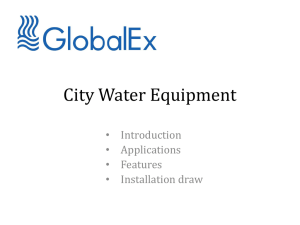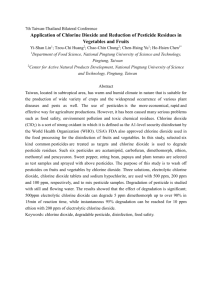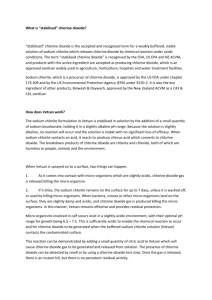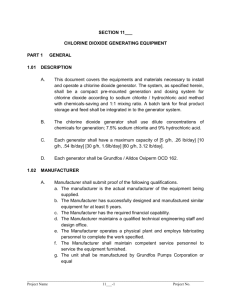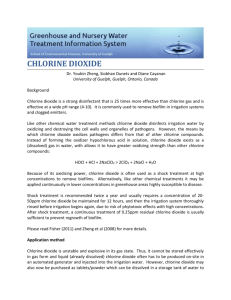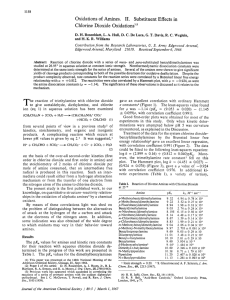Vetsan Datasheet Datasheet 1
advertisement
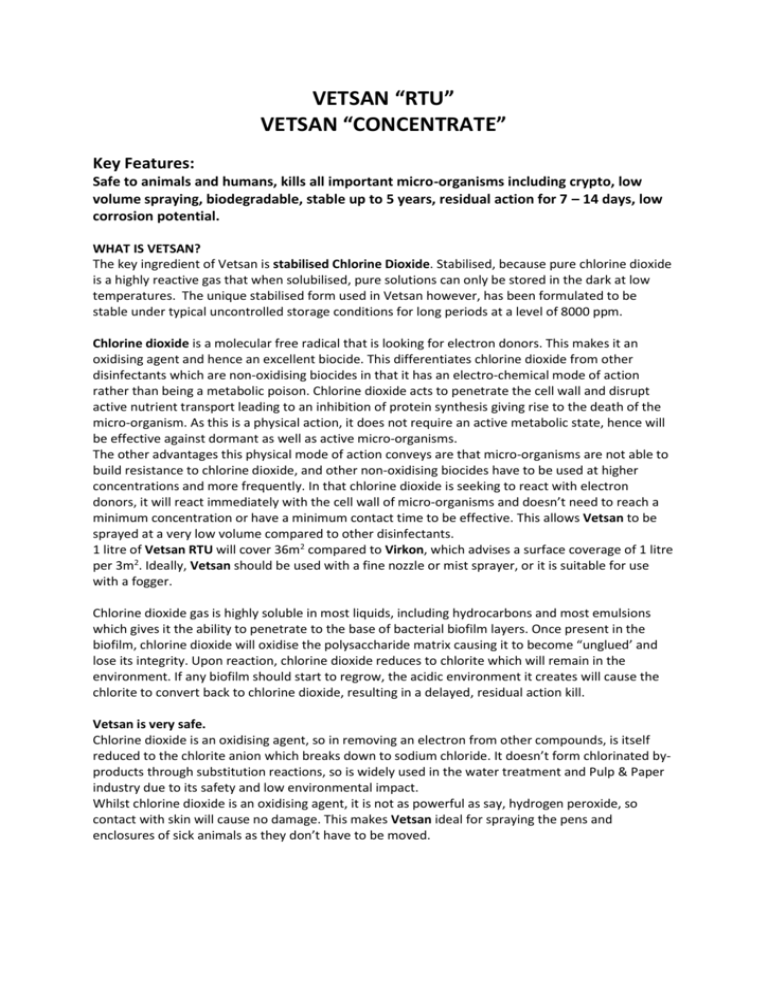
VETSAN “RTU” VETSAN “CONCENTRATE” Key Features: Safe to animals and humans, kills all important micro-organisms including crypto, low volume spraying, biodegradable, stable up to 5 years, residual action for 7 – 14 days, low corrosion potential. WHAT IS VETSAN? The key ingredient of Vetsan is stabilised Chlorine Dioxide. Stabilised, because pure chlorine dioxide is a highly reactive gas that when solubilised, pure solutions can only be stored in the dark at low temperatures. The unique stabilised form used in Vetsan however, has been formulated to be stable under typical uncontrolled storage conditions for long periods at a level of 8000 ppm. Chlorine dioxide is a molecular free radical that is looking for electron donors. This makes it an oxidising agent and hence an excellent biocide. This differentiates chlorine dioxide from other disinfectants which are non-oxidising biocides in that it has an electro-chemical mode of action rather than being a metabolic poison. Chlorine dioxide acts to penetrate the cell wall and disrupt active nutrient transport leading to an inhibition of protein synthesis giving rise to the death of the micro-organism. As this is a physical action, it does not require an active metabolic state, hence will be effective against dormant as well as active micro-organisms. The other advantages this physical mode of action conveys are that micro-organisms are not able to build resistance to chlorine dioxide, and other non-oxidising biocides have to be used at higher concentrations and more frequently. In that chlorine dioxide is seeking to react with electron donors, it will react immediately with the cell wall of micro-organisms and doesn’t need to reach a minimum concentration or have a minimum contact time to be effective. This allows Vetsan to be sprayed at a very low volume compared to other disinfectants. 1 litre of Vetsan RTU will cover 36m2 compared to Virkon, which advises a surface coverage of 1 litre per 3m2. Ideally, Vetsan should be used with a fine nozzle or mist sprayer, or it is suitable for use with a fogger. Chlorine dioxide gas is highly soluble in most liquids, including hydrocarbons and most emulsions which gives it the ability to penetrate to the base of bacterial biofilm layers. Once present in the biofilm, chlorine dioxide will oxidise the polysaccharide matrix causing it to become “unglued’ and lose its integrity. Upon reaction, chlorine dioxide reduces to chlorite which will remain in the environment. If any biofilm should start to regrow, the acidic environment it creates will cause the chlorite to convert back to chlorine dioxide, resulting in a delayed, residual action kill. Vetsan is very safe. Chlorine dioxide is an oxidising agent, so in removing an electron from other compounds, is itself reduced to the chlorite anion which breaks down to sodium chloride. It doesn’t form chlorinated byproducts through substitution reactions, so is widely used in the water treatment and Pulp & Paper industry due to its safety and low environmental impact. Whilst chlorine dioxide is an oxidising agent, it is not as powerful as say, hydrogen peroxide, so contact with skin will cause no damage. This makes Vetsan ideal for spraying the pens and enclosures of sick animals as they don’t have to be moved. Vetsan works. Chlorine dioxide as a sanitiser and disinfectant is a long proven technology and approved for use by the US FDA, EPA and UK Government. It is used widely for disinfection of drinking water, first introduced in 1944 at the Niagara Falls; and now carries EPA approval for use in hospitals, food processing plants, water systems and treatment of potable water amongst other things. Independent efficacy testing by Amdel NZ Ltd on cultures of strep and staph at the 80ppm level (as found in Vetsan RTU) gave a greater than 5 log reduction in cfu/ml between inoculum and recovery level after only 1 minute of contact time. Chlorine dioxide has proven toxicity and germicidal activity against a wide range of bacteria, viruses, fungi, protozoa and fungi including: Camphylobacter jejuni, Clostridium Sp, Coliforms, E coli, Salmonella Sp, Staphylococcus Sp, Streptococcus Sp, Cryptospordium parvum, Cryptococcidiosis, Toxoplasma gondii Coronavirus, Rotavirus, Parvovirus KEY FEATURES: Safe to use on animals and non-toxic to humans Residual activity over 7 – 14 days Biocidal over a wide pH range 4 – 12 Retains activity in both hard and soft water Low corrosion potential on infrastructure Long stability during storage, up to 5 years in original container Has a deodorising effect by oxidising odour molecules Build up of resistance impossible. Further information and details of the efficacy testing can be obtained from Vetpak Ltd
